Effects of Unloaded vs. Ankle-Loaded Plyometric Training on the Physical Fitness of U-17 Male Soccer Players
Abstract
1. Introduction
2. Materials and Methods
2.1. Ethical Approval
2.2. Participants
2.3. Experimental Design
2.4. Details of Standard and Modified Plyometric Training
2.5. Testing Procedures
2.5.1. Day 1
40-m Sprint
Sprint 9–3–6–3–9 m with 180° Turns (S 180°)
Sprint 4 × 5 m (S4 × 5 m)
2.5.2. Day 2
Anthropometry
Repeated Change of Direction Test
- Total sprint = sum of sprint times from all sprints
- Ideal sprint = the number of sprints × best sprint time
Sprint 9–3–6–3–9 m with Backward and Forward Running (SBF)
2.5.3. Day 3
Vertical JUMP
Five Jump Test
Dynamic Balance (Y-Balance Test)
2.5.4. Day 4
Static (Stork) Balance Test
Yo-Yo Intermittent Recovery Test Level 1
2.6. Statistical Analyses
3. Results
4. Discussion
Practical Applications
5. Conclusions
Author Contributions
Funding
Conflicts of Interest
References
- Bangsbo, J. The physiology of soccer-with special reference to intense intermittent exercise. Acta Physiol. Scand. Suppl. 1994, 619, 1–155. [Google Scholar] [PubMed]
- Chelly, M.S.; Fathloun, M.; Cherif, N.; Ben Amar, M.; Tabka, Z.; Van Praagh, E. Effects of a Back Squat Training Program on Leg Power, Jump, and Sprint Performances in Junior Soccer Players. J. Strength Cond. Res. 2009, 23, 2241–2249. [Google Scholar] [CrossRef] [PubMed]
- Garcia-Pinillos, F.; Martínez-Amat, A.; Hita-Contreras, F.; Martínez-López, E.J.; Latorre-Román, P.Á. Effects of a Contrast Training Program Without External Load on Vertical Jump, Kicking Speed, Sprint, and Agility of Young Soccer Players. J. Strength Cond. Res. 2014, 28, 2452–2460. [Google Scholar] [CrossRef] [PubMed]
- Silva, J.R.; Nassis, G.P.; Rebelo, A. Strength training in soccer with a specific focus on highly trained players. Sports Med. Open 2015, 1, 17. [Google Scholar] [CrossRef]
- Markovic, G.; Mikulic, P. Neuro-Musculoskeletal and Performance Adaptations to Lower-Extremity Plyometric Training. Sports Med. 2010, 40, 859–895. [Google Scholar] [CrossRef]
- Michailidis, Y.; Tabouris, A.; Metaxas, T. Effects of Plyometric and Directional Training on Physical Fitness Parameters in Youth Soccer Players. Int. J. Sports Physiol. Perform. 2019, 14, 392–398. [Google Scholar] [CrossRef]
- Negra, Y.; Chaabène, H.; Sammoud, S.; Bouguezzi, R.; Mkaouer, B.; Hachana, Y.; Granacher, U. Effects of Plyometric Training on Components of Physical Fitness in Prepuberal Male Soccer Athletes. J. Strength Cond. Res. 2017, 31, 3295–3304. [Google Scholar] [CrossRef]
- Ramírez-Campillo, R.; Alvarez, C.; Gentil, P.; LoTurco, I.; Sanchez-Sanchez, J.; Izquierdo, M.; Moran, J.; Nakamura, F.Y.; Chaabene, H.; Granacher, U. Sequencing Effects of Plyometric Training Applied Before or After Regular Soccer Training on Measures of Physical Fitness in Young Players. J. Strength Cond. Res. 2020, 34, 1959–1966. [Google Scholar] [CrossRef]
- Ramírez-Campillo, R.; Burgos, C.H.; Henríquez-Olguín, C.; Andrade, D.C.; Martínez, C.; Álvarez, C.; Castro-Sepúlveda, M.; Marques, M.C.; Izquierdo, M. Effect of Unilateral, Bilateral, and Combined Plyometric Training on Explosive and Endurance Performance of Young Soccer Players. J. Strength Cond. Res. 2015, 29, 1317–1328. [Google Scholar] [CrossRef]
- Zatsiorsky, V.M. Performance Biomechanics and Injury Prevention; Guanabara Koogan: Rio de Janeiro, Brasil, 2004. [Google Scholar]
- Verkhoshanskiy, Y.V. Osnovy spetsialnoy silovoy podgotovki v sporte. In Fundamentals of Special Strength Training in Sports; Sovetskiy Sport: Moscow, Russia, 2013. (In Russian) [Google Scholar]
- Platonov, V.N. System of Preparation of Athletes in Olympic Sports; Olympic Literature: Kiev, Ukraine, 2014. [Google Scholar]
- Hammami, M.; Negra, Y.; Aouadi, R.; Shephard, R.J.; Chelly, M.S. Effects of an In-season Plyometric Training Program on Repeated Change of Direction and Sprint Performance in the Junior Soccer Player. J. Strength Cond. Res. 2016, 30, 3312–3320. [Google Scholar] [CrossRef]
- Hammami, M.; Gaamouri, N.; Aloui, G.; Shephard, R.J.; Chelly, M.S. Effects of Combined Plyometric and Short Sprint With Change-of-Direction Training on Athletic Performance of Male U15 Handball Players. J. Strength Cond. Res. 2019, 33, 662–675. [Google Scholar] [CrossRef] [PubMed]
- Chmielewski, T.L.; Myer, G.D.; Kauffman, D.; Tillman, S.M. Plyometric Exercise in the Rehabilitation of Athletes: Physiological Responses and Clinical Application. J. Orthop. Sports Phys. Ther. 2006, 36, 308–319. [Google Scholar] [CrossRef] [PubMed]
- Cronin, J.B.; Brughelli, M.; Gamble, P.; Brown, S.R.; McKenzie, C. Acute Kinematic and Kinetic Augmentation in Horizontal Jump Performance Using Haltere Type Handheld Loading. J. Strength Cond. Res. 2014, 28, 1559–1564. [Google Scholar] [CrossRef] [PubMed]
- Rosas, F.; Ramirez-Campillo, R.; Abad-Colil, F.; Martinez-Salazar, C.; Caniuqueo, A.; Cañas-Jamet, R.; LoTurco, I.; McKenzie, C.; Gonzalez-Rivera, J.; Sanchez-Sanchez, J.; et al. Jump Training in Youth Soccer Players: Effects of Haltere Type Handheld Loading. Int. J. Sports Med. 2016, 37, 1060–1065. [Google Scholar] [CrossRef]
- Kobal, R.; Pereira, L.A.; Zanetti, V.; Ramirez-Campillo, R.; LoTurco, I. Effects of Unloaded vs. Loaded Plyometrics on Speed and Power Performance of Elite Young Soccer Players. Front. Physiol. 2017, 8, 742. [Google Scholar] [CrossRef] [PubMed]
- Verhagen, A.P.; de Vet, H.C.; de Bie, R.A.; Kessels, A.G.; Boers, M.; Bouter, L.M.; Knipschild, P.G. The Delphi list: A criteria list for quality assessment of randomized clinical trials for conducting systematic reviews developed by Delphi consensus. J. Clin. Epidemiol. 1998, 51, 1235–1241. [Google Scholar] [CrossRef]
- Mirwald, R.L.; Baxter-Jones, A.D.; Bailey, D.A.; Beunen, G.P. An assessment of maturity from anthropometric measurements. Med. Sci. Sports Ex. 2002, 34, 689–694. [Google Scholar]
- Sporis, G.; Jukic, I.; Milanovic, L.; Vučetić, V. Reliability and Factorial Validity of Agility Tests for Soccer Players. J. Strength Cond. Res. 2010, 24, 679–686. [Google Scholar] [CrossRef]
- Durnin, J.V.G.A.; Womersley, J. Body fat assessed from total body density and its estimation from skinfold thickness: Measurements on 481 men and women aged from 16 to 72 Years. Br. J. Nutr. 1974, 32, 77–97. [Google Scholar] [CrossRef]
- Wong, P.-L.; Chan, G.S.; Smith, A.W. Repeated-Sprint and Change-of-Direction Abilities in Physically Active Individuals and Soccer Players. J. Strength Cond. Res. 2012, 26, 2324–2330. [Google Scholar] [CrossRef]
- Glaister, M.; Howatson, G.; Pattison, J.R.; McInnes, G. The Reliability and Validity of Fatigue Measures During Multiple-Sprint Work: An Issue Revisited. J. Strength Cond. Res. 2008, 22, 1597–1601. [Google Scholar] [CrossRef] [PubMed]
- Gribble, P.A.; Hertel, J. Considerations for Normalizing Measures of the Star Excursion Balance Test. Meas. Phys. Educ. Exerc. Sci. 2003, 7, 89–100. [Google Scholar] [CrossRef]
- Cohen, J. Statistical Power Analysis for the Behavioural Sciences, 2nd ed.; Erlbaum Associates: Hillsdale, MI, USA, 1988. [Google Scholar]
- Vincent, W. Statistics in Kinesiology; Human Kinetics: Champaign, IL, USA, 1995. [Google Scholar]
- Saez de Villarreal, E.; Requena, B.; Cronin, J.B. The effects of plyometric training on sprint performance: A meta-analysis. J. Strength Cond. Res. 2012, 26, 575–584. [Google Scholar] [CrossRef]
- Wang, Y.C.; Zhang, N. Effects of plyometric training on soccer players. Exp. Ther. Med. 2016, 12, 550–554. [Google Scholar] [CrossRef] [PubMed]
- Behrens, M.; Mau-Moeller, A.; Mueller, K.; Heise, S.; Gube, M.; Beuster, N.; Herlyn, P.K.; Fischer, D.C.; Bruhn, S. Plyometric training improves voluntary activation and strength during isometric, concentric and eccentric contractions. J. Sci. Med. Sport 2016, 19, 170–176. [Google Scholar] [CrossRef] [PubMed]
- Chaabene, H.; Prieske, O. Change of Direction Speed: Toward a Strength Training Approach with Accentuated Eccentric Muscle Actions. Sports Med. 2018, 48, 1773–1779. [Google Scholar] [CrossRef] [PubMed]
- Sheppard, J.M.; Young, W.B. Agility literature review: Classifications, training and testing. J. Sports Sci. 2006, 24, 919–932. [Google Scholar] [CrossRef] [PubMed]
- Vissing, K.; Brink, M.; Lonbro, S.; Sorensen, H.; Overgaard, K.; Danborg, K.; Mortensen, J.; Elstrom, O.; Rosenhoj, N.; Ringgaard, S.; et al. Muscle adaptations to plyometric vs. resistance training in untrained young men. J. Strength Cond. Res. 2008, 22, 1799–1810. [Google Scholar] [CrossRef]
- Lloyd, D.G. Rationale for Training Programs to Reduce Anterior Cruciate Ligament Injuries in Australian Football. J. Orthop. Sports Phys. Ther. 2001, 31, 645–654. [Google Scholar] [CrossRef]
- Saez de Villarreal, E.; Suarez-Arrones, L.; Requena, B.; Haff, G.G.; Ferrete, C. Effects of Plyometric and Sprint Training on Physical and Technical Skill Performance in Adolescent Soccer Players. J. Strength Cond. Res. 2015, 29, 1894–1903. [Google Scholar] [CrossRef]
- Balsalobre-Fernandez, C.; Santos-Concejero, J.; Grivas, G.V. Effects of Strength Training on Running Economy in Highly Trained Runners: A Systematic Review With Meta-Analysis of Controlled Trials. J. Strength Cond. Res. 2016, 30, 2361–2368. [Google Scholar] [CrossRef]
- Issurin, V.B. Training transfer: Scientific background and insights for practical application. Sports Med. 2013, 43, 675–694. [Google Scholar] [CrossRef]
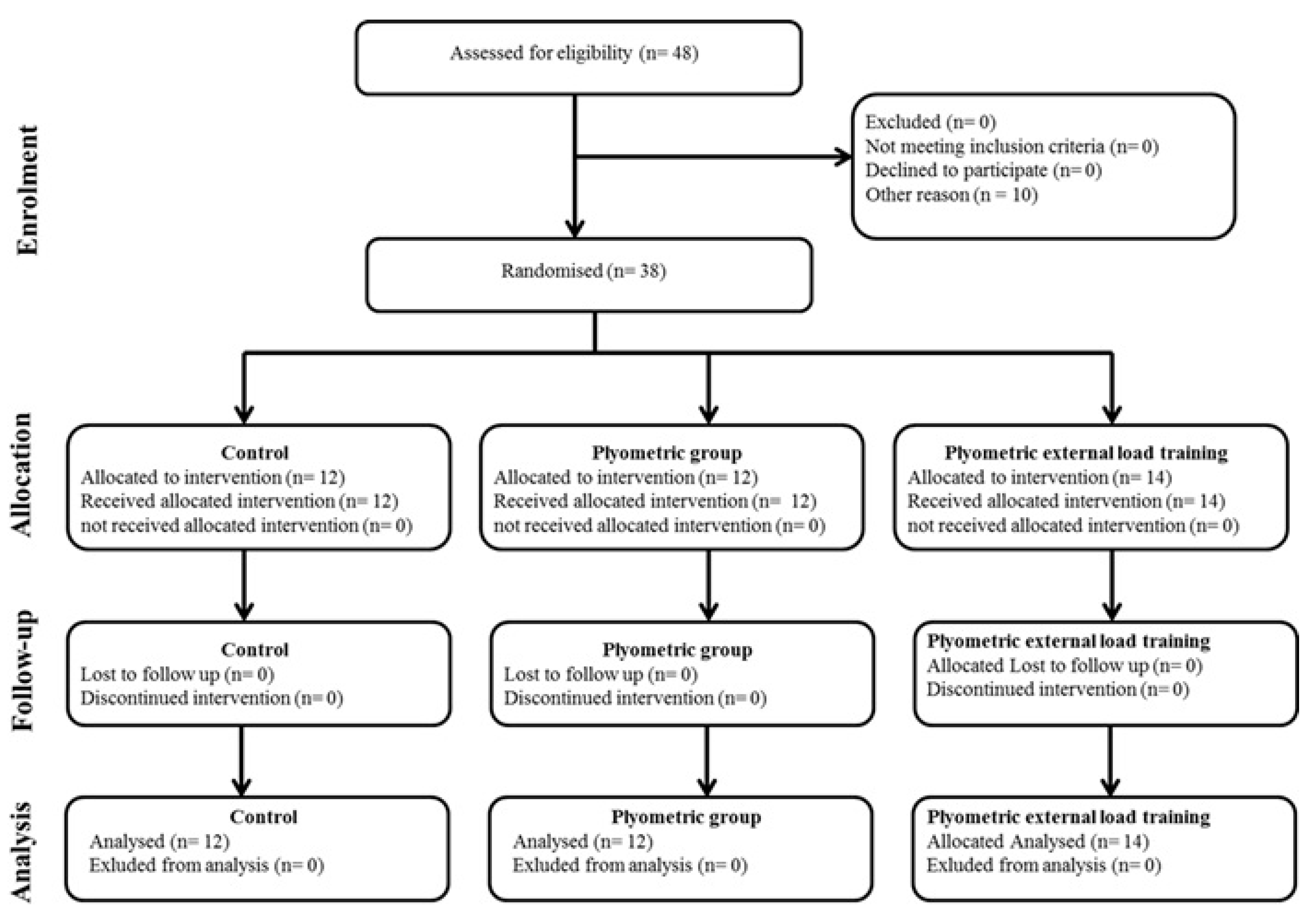
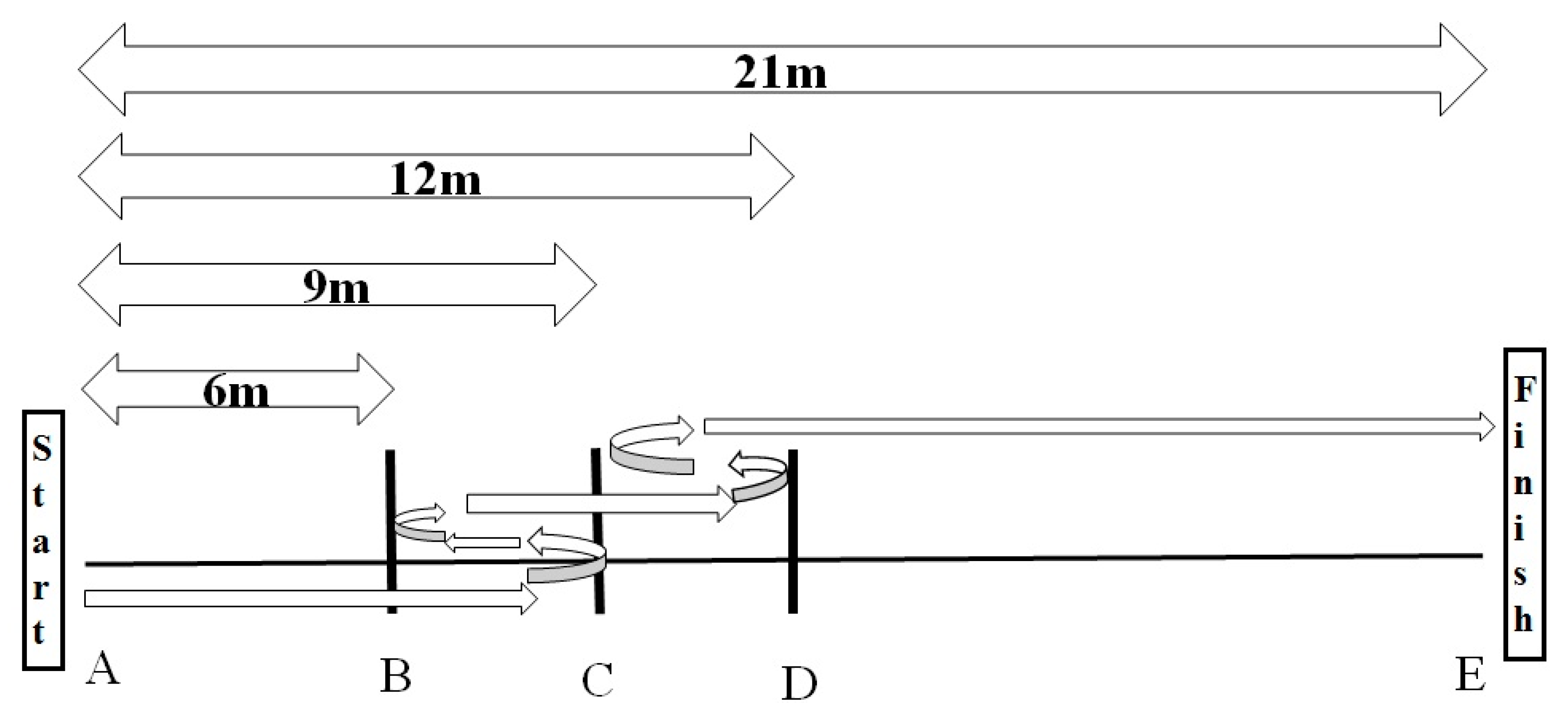
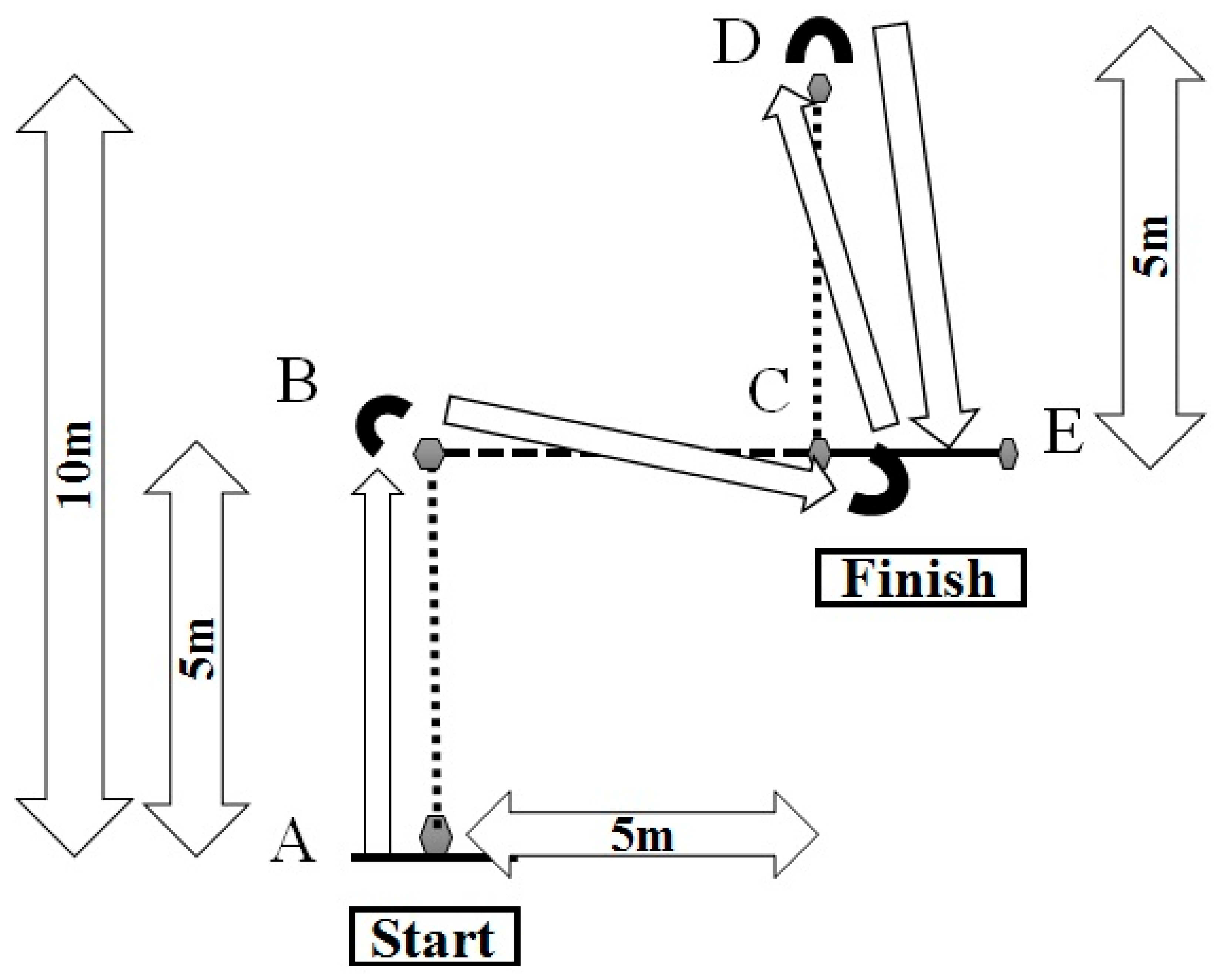
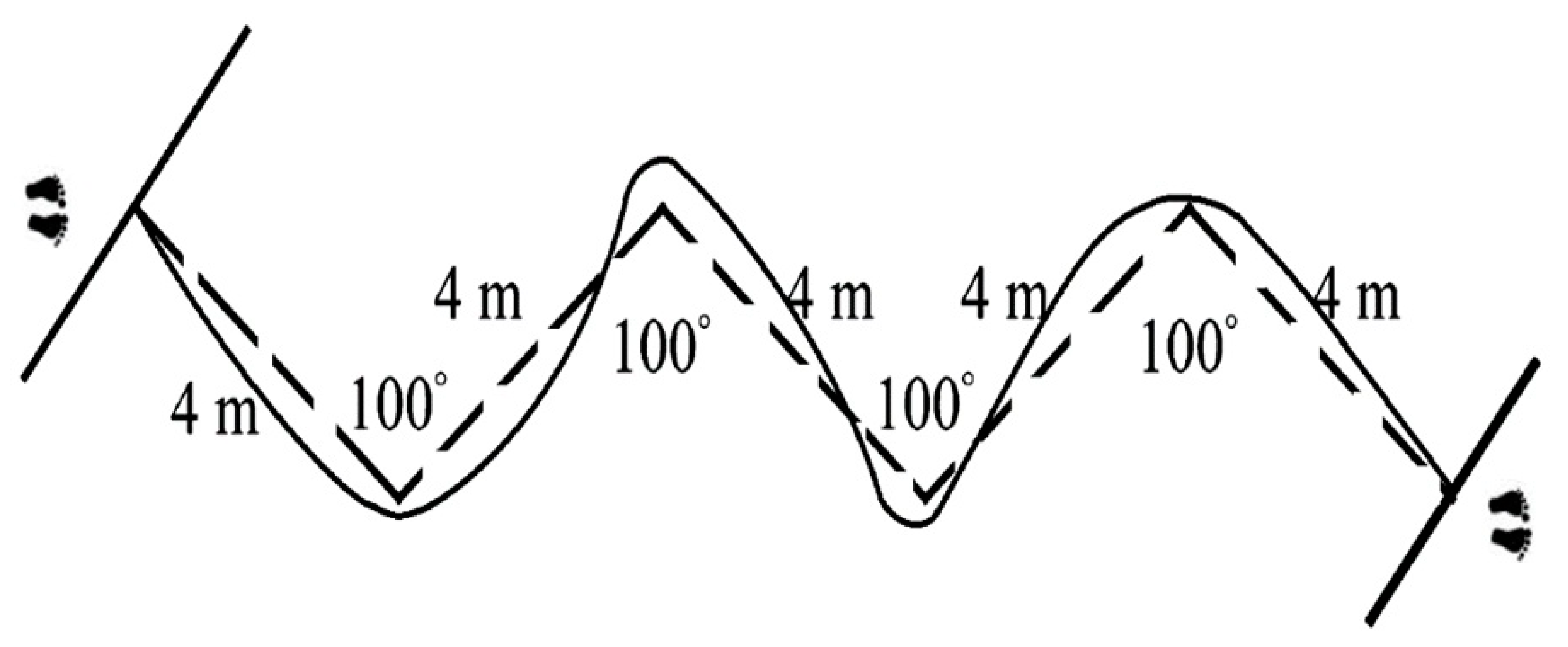
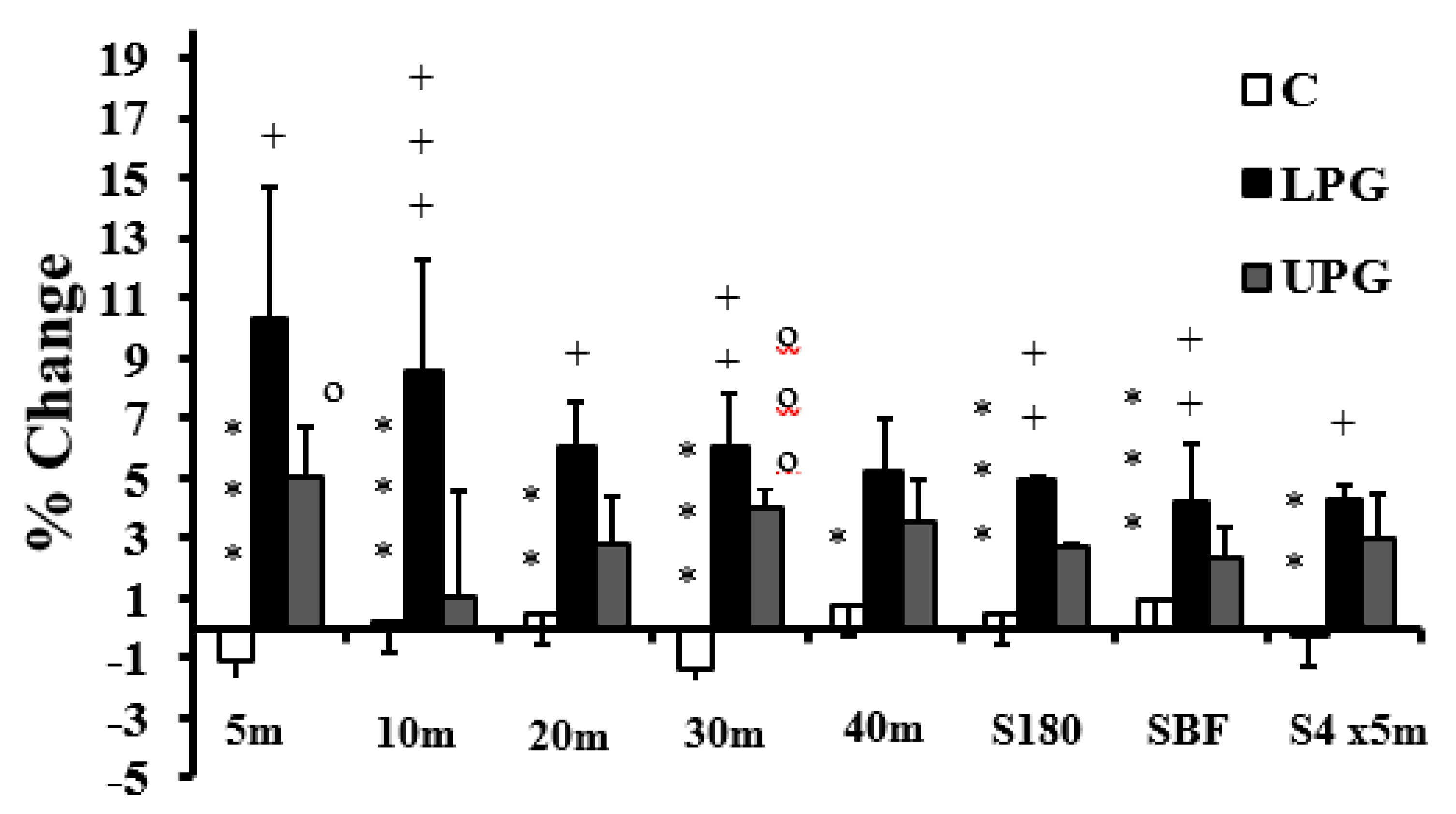
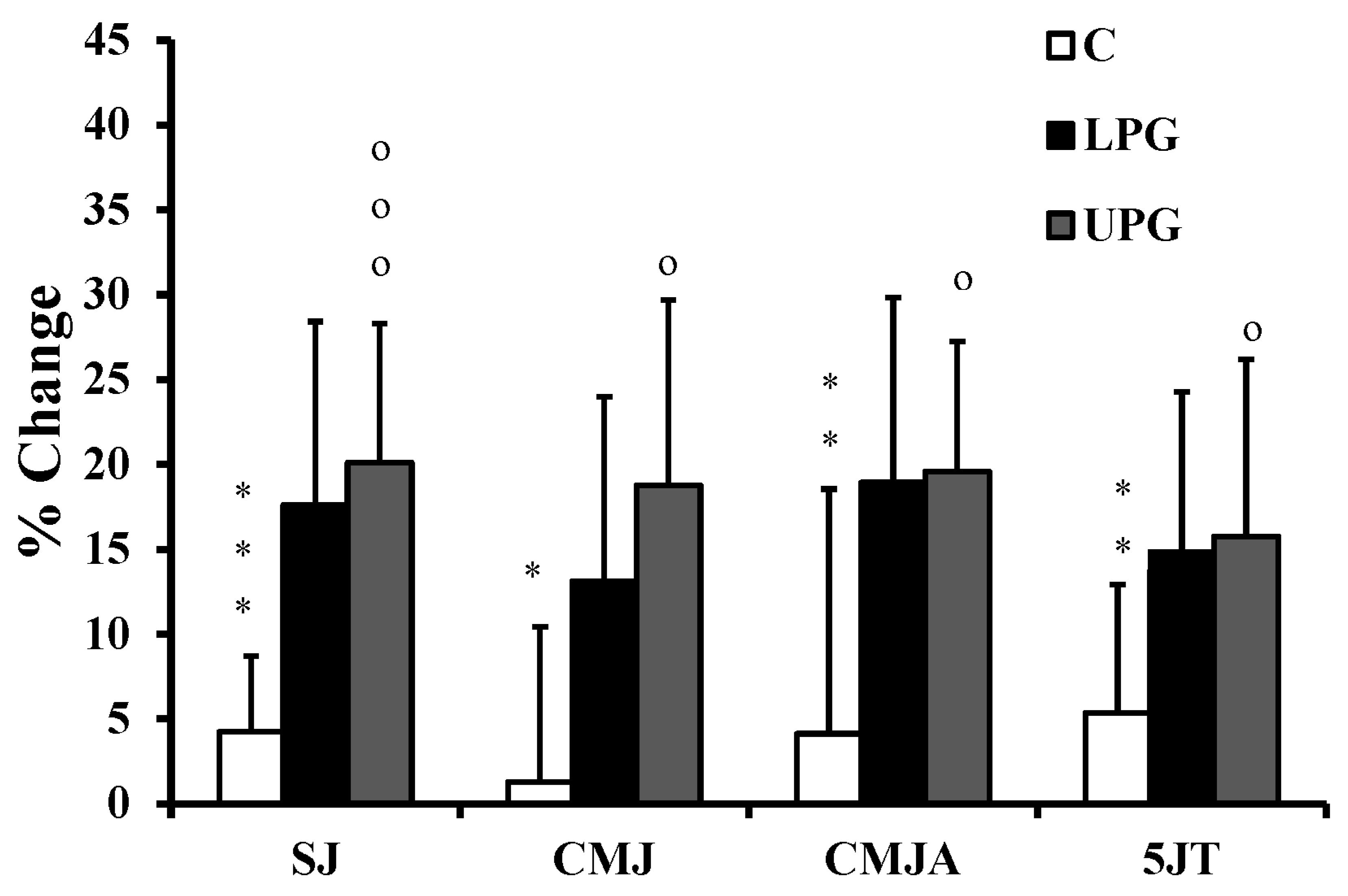
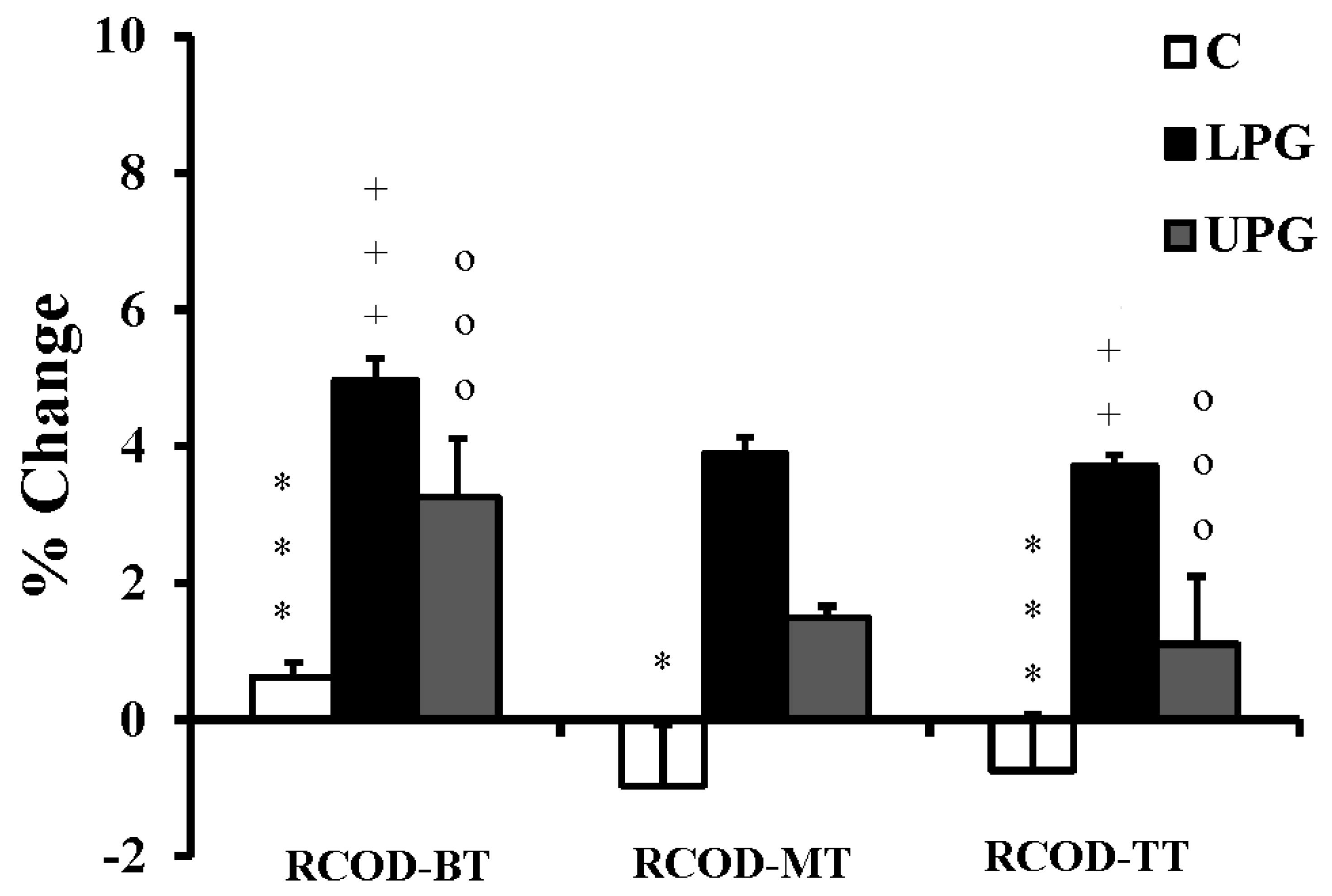
| 1 | Eligibility criteria | yes |
| 2 | Randomized allocation | yes |
| 3 | Concealed allocation | yes |
| 4 | Comparable at baseline | yes |
| 5 | Blinded subjects | no |
| 6 | Blinded therapist | yes |
| 7 | Blinded assessors | no |
| 8 | Adequate follow up | yes |
| 9 | Intention to treat analysis | no |
| 10 | Between group comparisons | yes |
| 11 | Point ability estimates and variance | yes |
| Total Score | 7/10 | |
| Weeks 1 and 2 | Weeks 3 and 4 | Weeks 5 and 6 | Weeks 7 and 8 | Weeks 9 and 10 | |
|---|---|---|---|---|---|
| Exercise 1: 3 hops to the right then 3 hops to the left (6 ground contacts), finally sprint 20 m. | 2 Repetitions | 3 Repetitions | 4 Repetitions | 5 Repetitions | 6 Repetitions |
| Exercise 2: 6 lateral 0.3 m hurdle jumps (3 to left and 3 to right) (6 ground contacts), then sprint 20 m. | 2 Repetitions | 3 Repetitions | 4 Repetitions | 5 Repetitions | 6 Repetitions |
| Exercise 3: 6 horizontal jumps (three bell feet horizontal with the right leg follows from three bell feet horizontal with the left leg) (6 ground contacts), then sprint 20 m. | 2 Repetitions | 3 Repetitions | 4 Repetitions | 5 Repetitions | 6 Repetitions |
| Exercise 4: 6 × 0.4 m hurdle jumps (6 ground contacts), then sprint 20 m. | 2 Repetitions | 3 Repetitions | 4 Repetitions | 5 Repetitions | 6 Repetitions |
| Total jump per each session | 48 (36 unilateral jump + 12 bilateral jump) | 72 (54 unilateral jump + 18 bilateral jump) | 96 (72 unilateral jump + 24 bilateral jump) | 120 (90 unilateral jump + 30 bilateral jump) | 144 (98 unilateral jump + 36 bilateral jump) |
| Parameters | ICC | CV |
|---|---|---|
| Sprint | ||
| 5 m | 0.90 | 1.8 |
| 10 m | 0.87 | 0.9 |
| 20 m | 0.89 | 1.8 |
| 30 m | 0.85 | 1.4 |
| 40 m | 0.90 | 1.6 |
| Change of direction | ||
| Sprint time over 9–3–6–3–9 m with 180° turns | 0.91 | 1.8 |
| Sprint time over 9–3–6–3–9 m with backward and forward running | 0.89 | 1.5 |
| Sprint time over 4 × 5 m | 0.89 | 2.1 |
| Jump tests | ||
| Squat jump | 0.86 | 5.1 |
| Countermovement jump | 0.87 | 5.0 |
| Countermovement jump aimed arms | 0.86 | 4.6 |
| Five jump test | 0.87 | 5.5 |
| Y Balance Test | ||
| Right support leg | ||
| Right leg/Left | 0.98 | 9.5 |
| Right leg/Back | 0.97 | 7.5 |
| Right leg/Right | 0.98 | 19.2 |
| Left support leg | ||
| Left leg/Left | 0.98 | 10.3 |
| Left leg/Back | 0.98 | 7.6 |
| Left leg/Right | 0.97 | 18.2 |
| Stork Balance Test | ||
| Right leg | 0.76 | 69.5 |
| Left leg | 0.88 | 70.6 |
| Variables | Group | Pre-Trial | Post-Trial | p Value | d (Cohen) | |
|---|---|---|---|---|---|---|
| Sprint | 5 m (s) | Loaded plyometric group | 1.17 ± 0.02 | 1.05 ± 0.06 ***,+ | <0.001 a | 1.36 (large) |
| Unloaded plyometric group | 1.16 ± 0.02 | 1.12 ± 0.05 o | <0.001 b | 1.26 (large) | ||
| Control | 1.17 ± 0.02 | 1.18 ± 0.05 | <0.001 c | 1.42 (large) | ||
| 10 m (s) | Loaded plyometric group | 2.12 ± 0.02 | 1.94 ± 0.08 ***,+++ | <0.001 a | 1.51 (large) | |
| Unloaded plyometric group | 2.12 ± 0.02 | 2.10 ± 0.08 | <0.001 b | 1.34 (large) | ||
| Control | 2.12 ± 0.02 | 2.12 ± 0.06 | <0.001 c | 1.58 (large) | ||
| 20 m (s) | Loaded plyometric group | 3.26 ± 0.05 | 3.07 ± 0.09 **,+ | 0.003 a | 0.85 (large) | |
| Unloaded plyometric group | 3.27 ± 0.06 | 3.08 ± 0.1 | <0.001 b | 1.04 (large) | ||
| Control | 3.24 ± 0.07 | 3.25 ± 0.08 | <0.001 c | 1.17 (large) | ||
| 30 m (s) | Loaded plyometric group | 4.55 ± 0.06 | 4.27 ± 0.08 ***,++ | <0.001 a | 1.74 (large) | |
| Unloaded plyometric group | 4.56 ± 0.05 | 4.42 ± 0.15 ooo | <0.001 b | 1.29 (large) | ||
| Control | 4.53 ± 0.07 | 4.62 ± 0.12 | <0.001 c | 1.5 (large) | ||
| 40 m (s) | Loaded plyometric group | 5.85 ± 0.10 | 5.55 ± 0.13 * | 0.021 a | 0.68 (medium) | |
| Unloaded plyometric group | 5.87 ± 0.09 | 5.68 ± 0.15 | <0.001 b | 1.42 (large) | ||
| Control | 5.85 ± 0.08 | 5.79 ± 0.24 | 0.027 c | 0.65 (medium) | ||
| Change of direction | Sprint time over 9–3–6–3–9 m with 180° turns (s) | Loaded plyometric group | 8.73 ± 0.14 | 8.30 ± 0.14 ***,++ | <0.001 a | 1.19 (large) |
| Unloaded plyometric group | 8.78 ± 0.14 | 8.54 ± 0.14 | <0.001 b | 1.62 (large) | ||
| Control | 8.71 ± 0.19 | 8.70 ± 0.13 | <0.001 c | 1.22 (large) | ||
| Sprint time over 9–3–6–3–9 m with backward and forward running (s) | Loaded plyometric group | 8.62 ± 0.14 | 8.26 ± 0.17 ***,++ | <0.001 a | 1.06 (large) | |
| Unloaded plyometric group | 8.67 ± 0.14 | 8.47 ± 0.14 | <0.001 b | 1.44 (large) | ||
| Control | 8.65 ± 0.13 | 8.57 ± 0.13 | 0.004 c | 0.82 (large) | ||
| Sprint time over 4 × 5 m (s) | Loaded plyometric group | 6.33 ± 0.16 | 6.08 ± 0.18 **,+ | 0.003 a | 0.85 (large) | |
| Unloaded plyometric group | 6.38 ± 0.14 | 6.26 ± 0.23 | 0.004 b | 0.71 (medium) | ||
| Control | 6.36 ± 0.13 | 6.37 ± 0.20 | 0.026 c | 0.66 (medium) | ||
| Jump tests | Squat jump (cm) | Loaded plyometric group | 33.7 ± 1.7 | 39.6 ± 2.8 *** | <0.001 a | 1.03 (large) |
| Unloaded plyometric group | 33.4 ± 1.9 | 40.0 ± 2.8 ooo | <0.001 b | 2.18 (large) | ||
| Control | 33.6 ± 1.7 | 35.0 ± 2.0 | <0.001 c | 1.06 (large) | ||
| Contermovement jump (cm) | Loaded plyometric group | 35.5 ± 1.7 | 40.2 ± 4.4 * | 0.010 a | 0.75 (medium) | |
| Unloaded plyometric group | 35.2 ± 1.9 | 41.7 ± 3.4 o | <0.001 b | 1.37 (large) | ||
| Control | 35.7 ± 1.8 | 36.1 ± 3.2 | 0.002 c | 0.88 (large) | ||
| Contermovement jump aimed arms (cm) | Loaded plyometric group | 37.3 ± 1.7 | 44.3 ± 2.9 ** | 0.005 a | 0.80 (large) | |
| Unloaded plyometric group | 36.7 ± 1.6 | 43.9 ± 3.7 o | <0.001 b | 1.87 (large) | ||
| Control | 37.5 ± 1.8 | 38.9 ± 4.5 | 0.001 c | 0.94 (large) | ||
| Five jump test (m) | Loaded plyometric group | 11.5 ± 0.8 | 13.2 ± 0.7 ** | 0.005 a | 0.81 (large) | |
| Unloaded plyometric group | 11.4 ± 0.5 | 13.0 ± 0.8 o | <0.001 b | 1.82 (large) | ||
| Control | 11.4 ± 0.6 | 12.0 ± 0.9 | 0.016 c | 0.71 (large) | ||
| Variables | Group | Pre-Trial | Post-Trial | p Value | d (Cohen) | |
|---|---|---|---|---|---|---|
| Repeated change of direction test | Repeated change of direction-BT (s) | Loaded plyometric group | 6.41 ± 0.07 | 6.07 ± 0.07 ***,+++ | <0.001 a | 2.14 (large) |
| Unloaded plyometric group | 6.42 ± 0.04 | 6.21 ± 0.07 ooo | <0.001 b | 3.33 (large) | ||
| Control | 6.41 ± 0.05 | 6.37 ± 0.05 | <0.001 c | 2.09 (large) | ||
| Repeated change of direction-MT (s) | Loaded plyometric group | 6.60 ± 0.07 | 6.13 ± 0.80 * | 0.014 a | 0.72 (medium) | |
| Unloaded plyometric group | 6.60 ± 0.07 | 6.50 ± 0.07 | 0.041 b | 0.50 (medium) | ||
| Control | 6.62 ± 0.05 | 6.68 ± 0.07 | 0.025 c | 0.66 (medium) | ||
| Repeated change of direction-DEC (%) | Loaded plyometric group | 4.45 ± 0.95 | 4.17 ± 0.45 ** | 0.001 a | 0.93 (large) | |
| Unloaded plyometric group | 4.23 ± 0.07 | 3.99 ± 1.36 ooo | 0.651 b | 0.10 (small) | ||
| Control | 4.67 ± 1.42 | 5.47 ± 0.05 | 0.065 c | 0.56 (medium) | ||
| Repeated change of direction-TT (s) | Loaded plyometric group | 39.60 ± 0.45 | 38.13 ± 0.41 ***,++ | <0.001 a | 1.94 (large) | |
| Unloaded plyometric group | 39.51 ± 0.48 | 39.07 ± 0.50 ooo | <0.001 b | 1.22 (large) | ||
| Control | 39.66 ± 0.41 | 40.03 ± 0.34 | <0.001 c | 1.82 (large) | ||
| Yo-Yo intermittent recovery test level 1 | Aerobic maximum speed (km.h−1) | Loaded plyometric group | 16.5 ± 0.5 | 17.0 ± 0.4 | 0.054 a | 0.58 (medium) |
| Unloaded plyometric group | 16.4 ± 0.4 | 17.0 ± 0.7 | <0.001 b | 0.89 (large) | ||
| Control | 16.3 ± 0.7 | 16.5 ± 0.5 | 0.609 c | 0.23 (small) | ||
| Total distance covered (m) | Loaded plyometric group | 1851 ± 247 | 2197 ± 348 | 0.01 a | 0.75 (medium) | |
| Unloaded plyometric group | 1950 ± 164 | 2133 ± 522 | 0.004 b | 0.71(medium) | ||
| Control | 1630 ± 427 | 1860 ± 415 | 0.715 c | 0.20 b(small) | ||
| Variables | Group | Pre-Trial | Post-Trial | p Value | d (Cohen) | ||
|---|---|---|---|---|---|---|---|
| Y Balance Test | Right support leg | Right leg/Left (cm) | Loaded plyometric group | 86 ± 8 | 91 ± 8 * | 0.027 a | 0.65 (medium) |
| Unloaded plyometric group | 82 ± 8 | 86 ± 7 | 0.097 b | 0.40 (small) | |||
| Control | 83 ± 8 | 83 ± 6 | 0.471 c | 0.29 (small) | |||
| Right leg/Back (cm) | Loaded plyometric group | 111 ± 7 | 118 ± 5 + | 0.014 a | 0.71 (medium) | ||
| Unloaded plyometric group | 106 ± 10 | 110 ± 9 | 0.015 b | 0.59 (medium) | |||
| Control | 109 ± 8 | 112 ± 7 | 0.679 c | 0.21 (small) | |||
| Right leg/Right (cm) | Loaded plyometric group | 55 ± 9 | 60 ± 9 | 0.185 a | 0.44 (small) | ||
| Unloaded plyometric group | 53 ± 12 | 53 ± 12 | 0.522 b | 0.15 (small) | |||
| Control | 52 ± 10 | 52 ± 10 | 0.554 c | 0.26 (small) | |||
| Left support leg | Left leg/Left (cm) | Loaded plyometric group | 88 ± 10 | 93 ± 10 + | 0.011 a | 0.74 (medium) | |
| Unloaded plyometric group | 82 ± 8 | 85 ± 5 | 0.066 b | 0.44 (small) | |||
| Control | 84 ± 7 | 87 ± 7 | 0.873 c | 0.12 (small) | |||
| Left leg/Back (cm) | Loaded plyometric group | 114 ± 6 | 121 ± 5 *** | 0.001 a | 0.98 (large) | ||
| Unloaded plyometric group | 109 ± 12 | 108 ± 10 | 0.286 b | 0.25 (small) | |||
| Control | 113 ± 6 | 112 ± 7 | 0.155 c | 0.46 (small) | |||
| Left leg/Right (cm) | Loaded plyometric group | 53 ± 8 | 55 ± 8 | 0.196 a | 0.43 (small) | ||
| Unloaded plyometric group | 55 ± 11 | 53 ± 11 | 0.630 b | 0.10 (small) | |||
| Control | 51 ± 11 | 47 ± 11 | 0.435 c | 0.31 (small) | |||
| Stork Balance Test | Right leg (s) | Loaded plyometric group | 2.24 ± 0.76 | 7.78 ± 4.50 * | 0.022 a | 0.68 (medium) | |
| Unloaded plyometric group | 3.37 ± 2.94 | 4.86 ± 3.42 | <0.001 b | 1.00 (large) | |||
| Control | 2.16 ± 0.61 | 3.35 ± 2.53 | 0.011 c | 0.74 (medium) | |||
| Left leg (s) | Loaded plyometric group | 2.08 ± 0.39 | 10.04 ± 6.79 ** | 0.008 a | 0.76 (medium) | ||
| Unloaded plyometric group | 2.99 ± 2.71 | 6.91 ± 5.74 | <0.001 b | 1.13 (large) | |||
| Control | 1.78 ± 0.51 | 3.18 ± 3.13 | 0.017 c | 0.70 (medium) | |||
Publisher’s Note: MDPI stays neutral with regard to jurisdictional claims in published maps and institutional affiliations. |
© 2020 by the authors. Licensee MDPI, Basel, Switzerland. This article is an open access article distributed under the terms and conditions of the Creative Commons Attribution (CC BY) license (http://creativecommons.org/licenses/by/4.0/).
Share and Cite
Hammami, M.; Gaamouri, N.; Suzuki, K.; Aouadi, R.; Shephard, R.J.; Chelly, M.S. Effects of Unloaded vs. Ankle-Loaded Plyometric Training on the Physical Fitness of U-17 Male Soccer Players. Int. J. Environ. Res. Public Health 2020, 17, 7877. https://doi.org/10.3390/ijerph17217877
Hammami M, Gaamouri N, Suzuki K, Aouadi R, Shephard RJ, Chelly MS. Effects of Unloaded vs. Ankle-Loaded Plyometric Training on the Physical Fitness of U-17 Male Soccer Players. International Journal of Environmental Research and Public Health. 2020; 17(21):7877. https://doi.org/10.3390/ijerph17217877
Chicago/Turabian StyleHammami, Mehrez, Nawel Gaamouri, Katsuhiko Suzuki, Ridha Aouadi, Roy J. Shephard, and Mohamed Souhaiel Chelly. 2020. "Effects of Unloaded vs. Ankle-Loaded Plyometric Training on the Physical Fitness of U-17 Male Soccer Players" International Journal of Environmental Research and Public Health 17, no. 21: 7877. https://doi.org/10.3390/ijerph17217877
APA StyleHammami, M., Gaamouri, N., Suzuki, K., Aouadi, R., Shephard, R. J., & Chelly, M. S. (2020). Effects of Unloaded vs. Ankle-Loaded Plyometric Training on the Physical Fitness of U-17 Male Soccer Players. International Journal of Environmental Research and Public Health, 17(21), 7877. https://doi.org/10.3390/ijerph17217877






